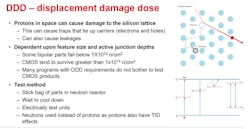Members can download this article in PDF format.
The demands of operating in a space environment bring unique challenges and unforgiving reliability requirements. Outside the protective cover of the Earth’s atmosphere, the solar system is filled with radiation. Space radiation can damage electronic devices, with potential effects ranging from performance degradation to a complete functional failure.
Due to the lower cost of low-Earth-orbit (LEO) launches, the space industry is now experiencing a rush to deploy small satellite constellations. These lightweight devices—up to a few hundred kilograms—typically operate at altitudes from 400 to 2,000 kilometers. They’re designed for objectives such as internet access and Earth observation missions. In the end, LEO apps will result in more products under development that were previously financially unfeasible to bring to market.
Sponsored Resources:
- Reduce SWaP with Space Plastic ICs
- TI’s Extensively Tested Space-Enhanced Plastic Devices
- Benefits of Space-Enhanced Plastic for LEO designs
LEO satellites are exposed to lower levels of radiation than traditional satellites launched into higher orbits. In addition, they’re built for shorter lifetimes. The expected lifetime for satellites in LEO is about five years, significantly lower than the 10- to 20-year requirements of a geostationary-orbit satellite. Thus, the required level of radiation immunity is lower.
It’s a relatively new market, but if you get these parameters right, end products will sell like beer in a college town
Rad Hardening
In space, ionizing radiation primarily takes the form of charged particles and x-ray radiation. In LEO, the dominant forms of radiation are heavy atomic nuclei, protons, alpha and beta particles, and high-energy photons from solar events. With ionizing radiation, the radiation energy of particles passes through the semiconductor material used to produce electronic components. This energy ruptures the chemical bonds, which in turn introduces changes in electronic component characteristics and can even damage the components.
Radiation-hardening is a process used by IC manufacturers to protect chips from the radiation sources that it may encounter. ICs can be hardened by fabricating them on an insulating substrate in place of the usual semiconductor base. Instead of conventional CMOS semiconductor wafers, silicon-on-insulator (SOI) or silicon-on-sapphire (SOS) are typical bases.
Space-grade SOI and SOS chips can survive radiation exposure levels between 1,000 and 3,000 Grays (100 and 300 krad). A Gray (Gy) is the international system of units—one Gray is equal to the absorption of 1 joule of radiation energy by one kilogram of matter (1 joule/kg). Use of a wide-bandgap substrate like silicon carbide or gallium nitride is helpful in hardening some devices.
In the space environment, designers must be concerned with two main causes of radiation. Single-event effects (SEEs) are random instantaneous cosmic rays and high-energy disruptions triggered by the passage of a single particle or photon. Proton-induced SEEs are the main concern for low Earth orbits and the major component from solar particle events.
Cumulative effects can be subcategorized into total ionizing dose (TID) and displacement damage dose (DDD) (Fig. 1). Total ionizing dose is basically chronic exposure to radiation. TID is a long-term failure mechanism, while SEE is an instantaneous failure mechanism. On that front, Texas Instruments has developed devices that are typically supported with TID and SEE test reports to address potential product degradation in a space environment.
Space-Enhanced Plastic
TI Enhanced Products (easily identifiable by the “-EP” ending of the product name) can be the answer for designers who need a higher level of quality and reliability than provided by COTS products. The company’s Space-Enhanced Plastic qualification process removes the need for high-risk and resource-intensive upscreening methods sometimes used in this market. Upscreening is the practice of testing a part electrically or environmentally for use outside of datasheet specifications.
Once you have an application in mind, the next task is to meet temperature requirements. TI’s Space EP products operate in a temperature range of −55 to +125°C, with electrical parameters tested and guaranteed to operate over those conditions. The commercial-grade temperature range is typically 0 to +70°C
Each item on the LEO agenda would pose significant challenges on its own. But designers must solve them all nearly simultaneously, adding layers of complexity to the tasks at hand.
Recently, there’s been more interest in using plastic encapsulated microcircuits (PEMs) in space for a variety of reasons. PEMs become more attractive because leading-edge products aren’t available in space-qualified varieties. They generally have smaller footprints and are lighter than the ceramic packages used in space-qualified products.
TI has worked with key avionics and defense designers to produce a level of PEMs that are reliable in critical applications, yet low-cost enough for wide use (Fig. 2). Its space-grade products are easily identifiable by the “SP” ending of the product name.
Similarly, the company’s line of space-enhanced plastic power-management parts provides a wide range of reliable devices to choose from to design spacecraft power systems at the right price point for LEO shorter duration missions. The breadth of TI’s space portfolio includes small radiation-hardened point-of-load power solutions, best-in-class sensor products, and some of the highest-performance data converters.
Conclusion
As the size, weight, and power consumption of space electronics components continue to shrink, engineers can expect new kinds of packaging, including greater use of chiplets and heterogeneous packaging of die. Designers also are bringing in analog-to-digital converters, digital-to-analog converters, and RF components into the package.
In summary, Texas Instruments’ Space EP products provide extensive radiation characterization to meet the requirements of LEO missions. The company also offers complete knowledge of the process used on its products.
With this information, TI can deliver products that have a high probability of being sufficiently radiation tolerant and can apply a process or design change to meet the radiation goal. After a part is selected, TI then verifies the choice with heavy ion, neutron displacement damage (NDD), and TID testing.
Sponsored Resources:


